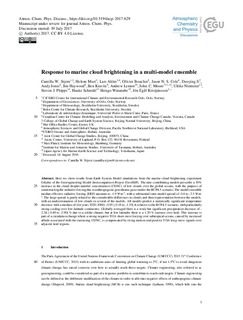Response to marine cloud brightening in a multi-model ensemble
Stjern, Camilla Weum; Muri, Helene; Ahlm, Lars; Boucher, Olivier; Cole, Jason N.S.; Ji, Duoying; Jones, Andy; Haywood, Jim M.; Kravitz, Ben; Lenton, Andrew; Moore, John C.; Niemeier, Ulrike; Phipps, Steven J.; Schmidt, Hauke; Watanabe, Shingo; Kristjansson, Jon Egill
Journal article
Submitted version
Permanent lenke
http://hdl.handle.net/11250/2479885Utgivelsesdato
2017Metadata
Vis full innførselSamlinger
- Journal articles [478]
Sammendrag
Here we show results from Earth System Model simulations from the marine cloud brightening experiment G4cdnc of the Geoengineering Model Intercomparison Project (GeoMIP). The nine contributing models prescribe a 50 % increase in the cloud droplet number concentration (CDNC) of low clouds over the global oceans, with the purpose of counteracting the radiative forcing due to anthropogenic greenhouse gases under the RCP4.5 scenario. The model ensemble median effective radiative forcing (ERF) amounts to −1.9 Wm−2, with a substantial inter-model spread of −0.6 to −2.5 Wm−2. The large spread is partly related to the considerable differences in clouds and their representation between the models, with an underestimation of low clouds in several of the models. All models predict a statistically significant temperature decrease with a median of (for years 2020–2060) −0.95 [−0.18 to −1.19] K relative to the RCP4.5 scenario, with particularly strong cooling over low-latitude continentss. Globally averaged there is a weak but significant precipitation decrease of −2.24 [−0.49 to −2.90] % due to a colder climate, but at low latitudes there is a 1.20 % increase over land. This increase is part of a circulation change where a strong negative TOA short-wave forcing over subtropical oceans, caused by increased albedo associated with the increasing CDNC, is compensated by rising motion and positive TOA long-wave signals over adjacent land regions.
